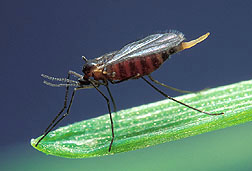|

Hessian fly. Click the image for more
information about it.
|
Hessian Fly-Resistant Wheat Germplasm
Available
By Jan
Suszkiw February 11, 2005
Three new spring wheat germplasm lines are now available for breeding
commercial wheat varieties resistant to the Hessian fly, Agricultural Research
Service (ARS) scientists report.
According to ARS geneticist
Steven
Xu, who is accepting seed requests, resistance in wheat is critical to
stopping the fly, during its maggot stage, from feeding inside the plant,
causing stems to buckle or stunting growth.
American farmers have been battling the 1/8-inch-long, mosquitolike
fly (Mayetiola destructor) since the Revolutionary War, when German
auxiliary troops for the British, called "Hessians," purportedly brought the
pest here in straw bedding. Today, M. destructor is a major insect pest
of wheat in most states where the crop is grown. Though sporadic, Hessian fly
outbreaks are costly, inflicting multimillion-dollar crop losses.
Adding to wheat growers' woes: The fly eventually overcomes the
defenses of resistant varieties by evolving into new strains, or biotypes. The
new spring wheat lines, dubbed "Synthetic Hexaploid Wheat" 8, 34 and 39, all
resist the Hessian fly Great Plains (GP) biotype. SW8 also resists the
H13-virulent strain, according to Xu, who is in the ARS
Cereal
Crops Research Unit, Fargo, N.D.
Xu collaborated with entomologist Marion Harris and geneticist Xiwen
Cai of North Dakota State University (NDSU)
at Fargo to evaluate the spring wheats' resistance to the fly and to
investigate the inheritance of that resistance. The initial cross-breeding work
was done in the 1980s by former ARS geneticist Leonard Joppa, notes Xu, who
will register the germplasm lines in the journal Crop Science.
The germplasm lines, which ARS and NDSU jointly released, derive their
Hessian fly resistance from goatgrass, Aegilops tauschii, a wild wheat
species that Joppa crossed with the durum wheat cultivar Langdon.
Resistant varieties alone aren't enough to completely stop the fly.
Wheat farmers also use delayed planting dates, biological control, crop
rotation and other strategies, according to Xu.
ARS is the U.S. Department of
Agriculture's principal scientific research agency.